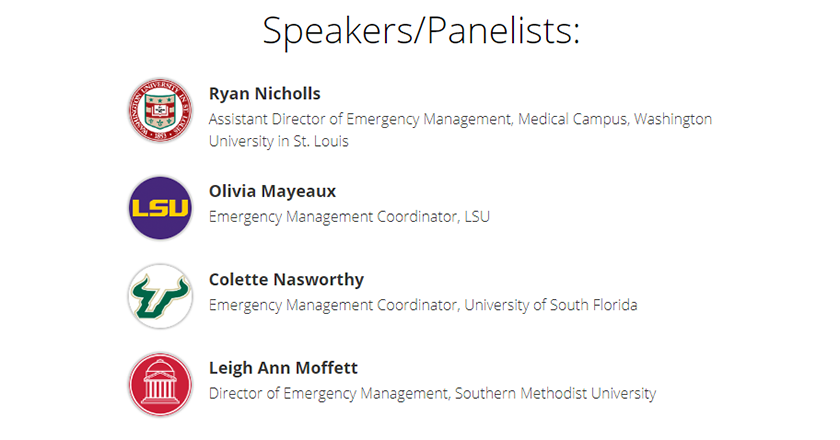Many of us are looking forward to a return to normal, and hope it will be sometime soon; at the same time, we need to recognize that the return will be slow and done in stages. For organizations across the world, responding to the pandemic and organizing the return is a priority, and a job of continuity planners and emergency managers.
Colleges and universities may face the most complex reopening challenges of any industry. These organizations must not only plan for their employees and students to return, but to reopen and continue operating numerous and diverse facilities, like labs, as well.
On May 21st, 2020, the Veoci team invited four emergency managers from higher education to participate in a webinar and discuss their experiences responding to the pandemic, and how they’re approaching reopening with their organization.
Below is a summary of the webinar. If you’d like to watch the recording, you can find it here.
â€

Adapting to COVID-19
The COVID-19 pandemic was sudden, and forced many people and organizations to quickly discover how their operations will have to change, and what tools they’ll need to continue pushing and gathering data, communicating and collaborating, and plan for an eventual reconstitution organization-wide.
Ryan Nicholls, Assistant Director of Emergency Management, Medical Campus at Washington University in St. Louis (WashU), has helped in this effort for his university’s medical school, which has 8,900 faculty and staff, 1,300 students, 1,600 beds in patient care areas, and 150 plus clinics totaling 15,000 weekly visits. The medical school is also associated with the St. Louis Children’s Hospital and the Barnes-Jewish Hospital, the latter of which the medical school shares an EOC with.
Ryan and his team built a number of Veoci solutions to respond to the crisis, including for daily institution reports, EOC information and call intakes, bulk ordering resources by department, and more. Being able to put together solutions on the fly was a critical piece of responding for WashU.
“As everyone experienced, COVID was unique in the EOC environment in that we had to practice social distancing and minimize in-person meetings. So Veoci really became a strong tool for that,” Nicholls said.
Information and data are instrumental in monitoring and controlling any emergency, and even more so for the COVID-19 pandemic. Leigh Ann Moffett, Director of Emergency Management at Southern Methodist University (SMU), needed a way to gather data and field requests coming in from students, professors, and other staff.
Southern Methodist University is located primarily in Dallas, Texas, a heavily urbanized area. The university also has a campus in Taos, New Mexico. In total, the university has 12,000 students and 3,000 employees. By March 17th, only essential staff were required on campus, and classes went remote by the 23rd. The university has already initiated its reopening as well, beginning their Phase 1 on May 18th.
Again, flexibility allowed Moffett and the SMU team to quickly put together forms for handling and gathering this information from constituents, and fielding requests for the continuation of travel for study and research. “This is a very agile system and easy to develop, even if you don’t have a very broad background in developing forms and workflows.”
Engaging Your Organization
The panelists agreed: COVID-19 has forced a wholly unique scenario for colleges and universities.
Rarely is an entire organization forced to respond to a disaster. To effectively respond to the COVID-19 pandemic, however, an entire organization needs to contribute. Returning to campus will require the same level of engagement. This means, for a college or university, involving all departments, public safety, university police, and leadership.
Colette Nasworthy, Emergency Management Coordinator at University of South Florida (USF), said her experience was positive, with numerous engagements from all sides of her university. USF has 4 campuses, over 50,000 students, and 16,000 employees.
Everyone understands the importance of planning in light of current events, and knows what it means for the upcoming Fall 2020 semester. They want a smooth return, and are willing to do their part in making it possible.”We have stakeholders engaged that are not typically engaged in our emergency operations, but everyone has been cooperative and very engaged in that planning process for returning to campus,” Nasworthy said.
Using a platform like Veoci, Moffett and Nicholls said, made getting what was needed from each department much easier. An innovative and digital response is required. Moffett and Nicholls both have people within their organizations already familiar with Veoci, making the process of collecting information from all sides simple. Even unfamiliar users found little trouble ramping into the tool and contributing how they can through it. It’s top-down engagement, which is imperative to a timely and effective response to the pandemic.
Information Reporting
Data is the crux of any response. Without reliable and steady information from stakeholders, conducting a response becomes difficult; to respond, emergency managers need to know the exact details of the scenario they’re up against.
Data also factors greatly into the recovery process as well. It supplements after-action review, showing planners gaps in plans, allowing the planners to correct those gaps for the next plan activation.
Certain universities and colleges across the U.S. are eligible for FEMA disaster reimbursements as well, placing an even stronger importance on data gathering as the event progresses. Olivia Mayeaux, Emergency Management Coordinator at Louisiana State University (LSU), elaborated on this further in the webinar.
“Unfortunately, being in Louisiana, we have a lot of experience with FEMA due to hurricanes. So one thing we make sure we do is start recording on our side as early as possible. Currently, we’re making sure we do all of our financial reports as we’re going through the event.”
Because so many people are isolated from each other and their work spaces, a digital platform has made the data gathering side of response and recovery much more streamlined for each of the practitioners speaking in this webinar.
Ensuring a Smooth Return to Campus
The panelists in this webinar discussed the topics above, and more, in the webinar. If you’d like to see the recording you can find it here.
Returning to campus will be a challenge, and one many emergency managers and continuity planners across higher education will need to thoroughly prepare for to ensure they limit the impact of the COVID-19 pandemic on their organizations.








